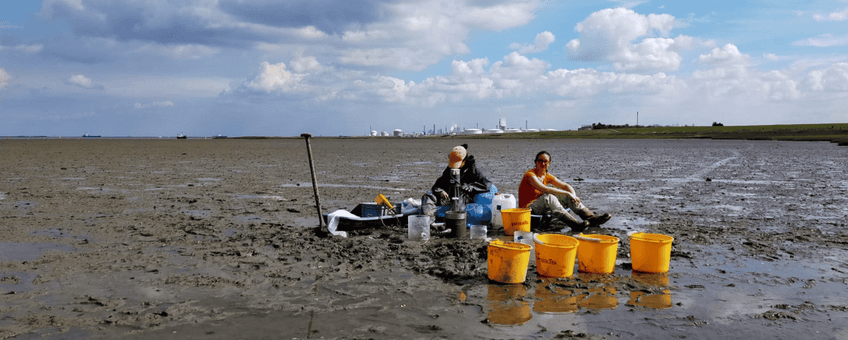
Stronger storms free more nutrients from mud flats
NIOZ Royal Netherlands Institute for Sea ResearchRios-Yunes will defend her PhD-thesis on March 1st at the University of Utrecht. “The dynamics of nutrients in deltas and estuaries have been a bit of a blind spot for marine science, so far”, she says.
Inflatable couch
For her experiments, Rios-Yunes spent many hours on an inflatable couch on the dry bottom of the Westerschelde and the Oosterschelde. “I mimicked a storm on the mud, using a bucket without a bottom and a big blender, stirring up the mud and measuring the release or the uptake of nitrogen and phosphorous. But, since I needed to do this for six hours in a row, I rapidly found out that I needed a little bit of comfort, sitting on the mud. The inflatable couch was my life saver during the field work”, she says jokingly.
As frivolous as it may seem - mixing mud in an open bucket - this experiment is indeed a good model for a real storm, Rios-Yunes emphasizes. "We only mixed the top millimeters to a maximum of three centimeters of the sediment, whereas a real storm can stir up the soil to 20 cm deep. Also, the speeds of our mixer were lower than what sometimes happens in real life during a severe storm. Reality can, therefore, be more severe than out experimental set-up."
More nitrogen, less phosphorous
Rios-Yunes found out that considerable amounts of nitrogen are released when her experimental storm stirs the bottom. “In just a couple of hours, the amount of nitrogen that is normally released in weeks, may come out of the mud during one storm. This means that much more nutrients become available in the water column, and these could be used by algae to grow.” Phosphorous, on the other hand, was taken up during the ‘storm’ in the Oosterschelde but released in the Westerschelde. “This may be because of the differences in chemical composition of the mud between an estuary and a tidal bay.”

Ecosystem services
By storing nutrients such as nitrogen and phosphorus, the sediments of the Oosterschelde and Westerschelde, among others, provide a valuable ecosystem service. Without the storage of these fertilizers in the soil, even more nitrogen would be released into the environment, while this is already problematic. But this ecosystem service is under increasing pressure, Rios-Yunes explains. For example, the coast of the Oosterschelde is relatively important for the storage of nutrients, compared to the subtidal sea bottom. But due to the storm surge barrier (Oosterscheldekering) and also with rising sea levels in the future, the coast of the Oosterschelde is ‘eaten' by the currents. “Therefore, relatively large amounts of nutrients may become available for algae and other organisms.”
Equilibria and coastal squeeze
Temperature and salinity, as well as benthic animals also influence the chemistry of the tidal sea floor. “But these phenomena have not been studied a lot, so far”, Rios-Yunes says. “For fundamental research into the dynamics of nutrients and other equilibria in tidal areas, it is very important to understand the role of temperature, salinity, and benthic animals, like worms or bivalves, and also turmoil by storms.”
Policy makers and keepers of natural areas like the Oosterschelde should also understand the dynamics of nutrients in a changing world, Rios-Yunes says. “My research stresses the importance to keep the coast of these tidal areas in a good condition, and thus avoid losing the valuable ecosystem services they provide.”
Temporary effects
"Rios-Yunes' research makes an important contribution to the understanding of nutrient cycles in tidal regions", says the promotor of this PhD-research, Karline Soetaert, professor of geochemistry at Utrecht University and researcher at NIOZ in Yerseke. Soetaert stresses that nitrogen fluxes from tidal sediments do not play a structural role in the current nitrogen crisis. "Storms can cause nutrients to be released earlier into the water, but in the long term these will not be a structural source of nitrogen."
Text: NIOZ
Photos: Tim Grandjean (lead photo: collecting samples); Pieter van Rijswijk
